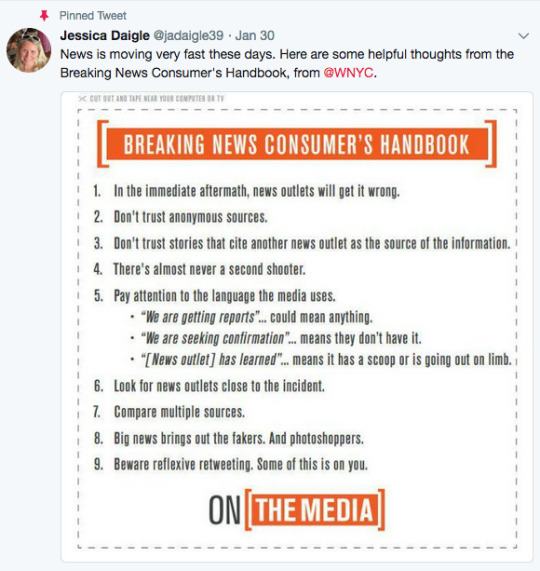Don't wanna be here? Send us removal request.
Photo

On January 30 of this year, I tweeted an image taken from WNYC’s On the Media blog. Titled “Breaking News Consumer’s Handbook,” it is a list of tips for sorting good information from bad while reading about breaking events. I don’t remember now what event I was reacting to when I posted it. The headlines on January 30, just ten days after President Trump’s inauguration, were full of the global reaction to his travel ban, news about a shooting at a mosque in Quebec which killed 6 and injured 8, and it was the day that Trump fired Sally Yates. I’ve been on Twitter since 2011, and until this year I tweeted infrequently and mainly about the Washington Redskins, never getting more than 20 or 30 views. This tweet, however, has been seen over 4000 times and was retweeted 19 times.
https://twitter.com/jadaigle39/status/826188059582488577
Melody Kramer included my tweet in an article published on February 8 on www.poynter.org, “Here’s how to cover President Trump’s tweets, and I’m sure that is where most of my views came from. In it, she wrote, “On The Media’s response to breaking news is smart because it doesn’t matter what the breaking news event is.” Breaking news is, by definition, information about an event that is developing, so obviously the first reports about that event will not be complete. Social media has made the spread of incorrect information – and disinformation – even more of a problem.
Since President Trump’s January 20 inauguration, news has been coming at us so fast it is hard to follow. Alt-right and ultra-left “news” sites have popped up all over the internet, and drive traffic to their websites using clickbait headlines; Facebook’s algorithms push news that agrees with your political views to the top of your newsfeed; Twitter bots stand at the ready to make hashtags trend and shut down dissent. Some mainstream media like CNN and New York Times have published stories that later turn out to be untrue. President Trump’s prolific and often caustic tweeting drive conversation on the morning “news” shows away from policy and toward his latest Twitter beef or demeaning nickname for other world and US leaders. In the last three days, North Korea launched an ICBM that might be capable of striking anywhere in the United States; Minority leaders Chuck Schumer and Nancy Pelosi cancelled a meeting with President Trump after he slammed them in a tweet; and the bursting dam of sexual harassment and sexual assault allegations against men in power in entertainment, politics and business continued swept Matt Lauer out of his job at the Today Show; and Project Veritas tried to persuade a Washington Post reporter to publish a made up story about being abused by Alabama Senate candidate Roy Moore. It’s possible that many people missed the news that the FCC has voted to loosen long-standing media ownership rules, which directly impacts us as news consumers.
How is it possible to separate the truth from the spin? The real news from the propaganda? Who should we believe about bias in the media? Why do stories break when they do? Are the daily headlines and tweets just smoke and mirrors to distract us from the authoritarian slide of our government or are “citizen” journalists finally telling us what the mainstream media has been trying to hide?
As an ex-journalist and an ex-prosecutor, I have been disheartened by what I see people posting on Facebook and Twitter. Hearts and minds are being calcified by headlines like “Jeff Sessions Laughs and Jokes about Committing Perjury, Colluding with Russians,” and “Media Promotes Gay Pedophilia Movie as ‘Oscar worthy’ in Midst of Hollywood’s Pedophilia Problem.” Ugh. The logical fallacies encapsulated in these two headlines is enough to keep me up all night worrying about the fate of our nation. If millions of people in our country are uncritically reading stories like these—or, worse, just reading the headlines and not actually taking the time to read the story itself—how can we know what is reliable and what is not? How will we come together and bridge this political divide?
My background as a journalist for a conservative newsmagazine and as a lawyer who spent years prosecuting sex crimes is tailor made for what is happening in America right now. I read the news with a critical eye and I know enough about how journalism works to be able to differentiate the wheat from the chaff. I know enough about the law, how courtrooms work and criminal cases develop to distinguish sexual assault from sexual harassment. Add to that my longtime interest in politics (I worked on Steny Hoyer’s campaign for Lieutenant Governor or Maryland in 1978 when I was 11 years old and I’ve worked on campaigns or for the Board of Elections almost every election since) and the maelstrom of breaking news that comes at us every day is my raison d’etre.
I hope to be able to show my readers how to navigate this world of nonstop breakneck news cycles. I would like to provide a road map for how to read the news, whether it is breaking events like the mass shooting in Las Vegas in early October or the slow drip drip drip of leaks about Mueller’s investigation into Russian interference in the 2016 election. I plan to point out my biases when necessary and I don’t expect to change anyone’s politics. But I hope that learning how to be a responsible news consumer will allow us to have a civil conversation without being overly partisan.
0 notes